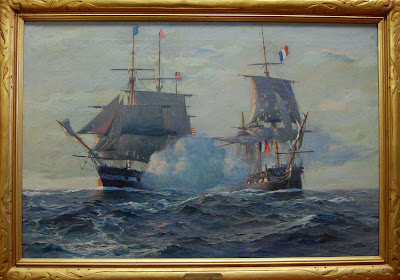Discovery of British Frigates and the University of Rhode Island
After years of oppressive British policies which stifled commerce in Narragansett Bay and surrounding communities, the Colony of R.I. and Providence Plantations renounced allegiance to the Crown on May 4, 1776: “Whereas George the third, forgetting his dignity, instead of protecting, is endeavoring to destroy the good people of this colony by sending fleets and armies to America to confiscate our property and spread fire, sword and desolation throughout our country!” With this the die was cast and any possibility of reconciliation with the British was destroyed.
On December 7, 1776 the British responded to this rebellious act by sending a large naval fleet and thousands of soldiers to Newport. This force managed to land without any significant resistance, much to the surprise of the invaders. Not only did this largely negate R.I.’s small navy, who were forced into the safety of Providence, it gave the British control of Narragansett Bay. According to Royal Navy Admiral Rodney the Bay was: "the best and noblest harbor in America, capable of containing the whole Navy of Britain and was a 48 hour sail from Boston, New York and Philadelphia.” This occupation put a choke hold on commerce and caused great damage to many buildings on Aquidneck Island and communities surrounding the bay.
| Chart showing position of British vessels just prior to arrival of the French fleet and final resting place of the scuttled frigates. |
After surviving the hostile behavior of the British for over two years, a glimmer of hope appeared on the horizon when a treaty of alliance and commerce between France and America was signed on February 6, 1778. Amongst other stipulations, this treaty agreed that a French squadron of 12 ships of the line and 4 frigates would be fitted out at Toulon for service in America. This fleet arrived off Delaware on July 8, attempting to surprise the British fleet, though the ships had already departed for New York. The large French vessels did not attempt to cross the bar at Sandy Hook and at the urging of George Washington turned their attention to Newport. The French arrived off Point Judith on July 29 and set in motion pre-arranged acts of destruction and abandonment shortly thereafter. The first step in this process was to unload the guns and most supplies in preparation for scuttling, denying the French the opportunity to capture any Royal Navy vessels.When the main French fleet entered Narragansett Bay on August 5, HMS Orpheus a 32 gun frigate with 220 crew was run aground at Almy’s Point and set on fire a few miles north of Newport on the west side of Aquidneck Island with Juno, Lark and Cerberus suffering the same fate.
| French fleet entering Narragansett Bay on August 5, 1776. |
The hulls of these once formidable ships were largely forgotten for nearly 200 years, settling into the muddy bottom of the Bay in what is now Portsmouth, R.I., except for Juno, farthest south in Middletown. Inspired by British and American maps created shortly after the mass scuttling, Al Davis, a graduate student in ocean engineering at University of Rhode Island (URI) located the remains of Lark and Cerberus by visual observation in 1972. His discovery convinced the ocean engineering department to assume overall responsibility for the entire project. Utilizing acoustical remote sensing and visual observation of air bubbles caused by decay of her wooden timbers, Orpheus was discovered in October of 1973. She was selected for excavation due to several factors including minimal current and the convenience of a nearby recreational marina.
In the summer of 1974, URI offered two field sessions excavating Orpheus, and I was fortunate to participate as an undergraduate student there. By early September of that year 84 feet of her keel had been exposed and thousands of artifacts had been recovered. A representative sample of these items including one of her 12 swivel guns are now on exhibit at the NWC Museum. These artifacts include iron and lead cannon balls, and most surprising, wooden rigging blocks and even a leather shoe sole. It is estimated that less than 10% of the artifacts have been recovered from the Orpheus site due to insufficient funding at the time. The artifacts on display are on loan from the Rhode Island Historic Preservation Commission in Providence which also holds the remainder of items recovered.
These artifacts are tangible evidence of a naval action scarcely mentioned in most history books and is merely the tip of the iceberg of what remains in the waters of Rhode Island. The excellent organic preservation of the wood and leather is credited to the anaerobic site conditions and the rapid burial as the heavy timbers settled into the mud. This burial also protected the wreck site by preventing the destructive marine mollusk teredo navalis from devouring exposed wood much like underwater termites. During this time period, the Royal Navy began experimenting with copper sheathing on hulls to mitigate marine growth and teredo damage much like toxic chemicals in bottom paint used today.
| Display case in NWC Museum. |
This incredible state of preservation is even more remarkable considering the intensive commercial and military activity which occurred just yards away beginning in the Civil War. In 1862 Lovell General Hospital was built to care for both Union and Confederate soldiers near the remains of the Orpheus. A long pier was built to accommodate the steam vessels bringing in the wounded. By the end of the war 10,593 patients were cared for at Lovell. The hospital was followed by a coaling station later in the 19th century, as well as the United States Navy's principal Patrol Torpedo (PT) Boat Training Facility, or Melville, which was located just a stone's throw from the Orpheus wreckage site during World War II.
Bob Cembrola
Naval War College Museum
Exhibitions Manager


Comments
Post a Comment